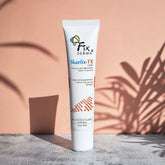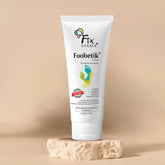Understanding Vitiligo: A Comprehensive Guide to Causes, Diagnosis, and Care

Lighter-toned or white patches appearing on the skin are termed as a condition of vitiligo. Starting with smaller sections of light-toned dots on the skin, it gradually becomes larger patches on the body. The intensity of the patches differs from person to person depending upon the internal body factors and environmental factors. Several topical treatments, light therapies, and surgical methods are available to de-pigment and even out the skin tone.
Furthermore, in this blog, we will take a deep dive into the understanding of vitiligo, its causes, symptoms, and various aspects of vitiligo, from its identification to treatment and support options.

Understanding Vitiligo:

Vitiligo is a chronic skin condition characterized by the loss of pigmentation, resulting in white patches on the skin. This occurs when melanocytes, the cells responsible for producing melanin (the pigment that gives skin its color), are destroyed. The condition can affect any part of the body, including the skin, hair, and even the inside of the mouth. The areas on the area where the pigment has been lost less than 1 cm are called macules and if larger than 1 cm, they are called patches. According to the survey, about 1% of the global population suffers from this condition, including males, females, and children of all age groups.
How to Diagnose Vitiligo?
Vitiligo typically presents as patches of skin that are lighter than the surrounding areas. These patches can vary in size and shape and may occur anywhere on the body. Commonly affected areas include the face, hands, arms, feet, and genitals. In some cases, hair growing in areas affected by vitiligo may turn white or gray.
Professional diagnosis for vitiligo involves studying the medical background of the family and physical examinations that help evaluate the skin condition. A black-light/ UV light is used to diagnose the condition as the affected areas of the skin appear chalky under it, making the diagnosis easier. Blood tests for autoimmune diseases, eye examination for uveitis, and skin biopsy are other methods included in the effective diagnosis of vitiligo.
Who is Affected by Vitiligo?
Vitiligo is a skin disorder that affects people of all skin kinds, regardless of gender or color, however, it is more visible in darker tones. Before age 30, the initial macule-like symptoms of vitiligo become patches. Vitiligo can be more likely to occur in people with Addison's disease, anemia, diabetes (type 1), lupus, psoriasis, rheumatoid arthritis, and thyroid illness, among other autoimmune diseases.
Factors Causing Vitiligo: Autoimmune, Genetic, Stress, and Environmental Factors
The immune system attacks melanocytes in the body due to several reasons including genetic and environmental factors. The below-mentioned factors contribute to the development of vitiligo.
- Autoimmune response: The immune system attacks melanocytes, the cells that contribute to the production of melanin, resulting in pigmentation of the skin, mistaking them for harmful foreign invaders.
- Genetic factors: An autoimmune disease or family history of vitiligo can increase the risk. A genetic mutation in the body can affect the function of melanocytes. Blood relatives having vitiligo and other autoimmune diseases, melanoma and patients who are going through immunotherapy are also at risk of vitiligo.
- Stress: Both physical and emotional stress can trigger melanocyte production in the body.
- Environmental triggers: Factors like UV radiation and exposure to certain chemicals like Phenol can contribute to the onset of vitiligo.
Understanding the Types of Vitiligo

Types of vitiligo include:
- Generalized: The most common type of vitiligo that causes patches to appear on the skin.
- Segmental: Affects only parts of the body such as hands or face and occurs at a younger age.
- Mucosal: Affects mucous membranes, such as the mouth or genitals.
- Focal: A rare type that is formed in the form of macules in small areas. These will not spread in a predictable pattern for one or two years.
- Trichome: Characterized by patches with a white center, a lighter patch around it, and an area of natural skin tone.
- Universal: A rare and extensive form of vitiligo that can affect almost 80% of the body to be depigmented.
Is There a Cure for Vitiligo?
Although there is no effective cure for vitiligo, there are medications and therapies that can restore pigmentation in depigmented areas.
Effective Treatments for Vitiligo
Topical Medications for Vitiligo Management
There are topical creams and ointments available for vitiligo such as:
- Corticosteroids: These are effective for people who have developed vitiligo recently. These are to be used under the care of an expert as prolonged use can have side effects on the skin such as skin thinning. Corticosteroids reduce the inflammation of the skin as well.
- Calcineurin inhibitors: These are often used on eyelids, face, neck, armpits and groin as these areas are sensitive and are at high risk from side effects caused by Corticosteroids.
- Calcipotriene: This medicine is often used with corticosteroids to bring much better effects on the skin.
- Ruxolitinib cream: This FDA-approved medicine is used to treat patchy vitiligo in children and adults above the age of 12.
Topical treatments for vitiligo have to be taken under the guidance of a medical expert. It will take 24 weeks or longer to start showing effects on the skin.
Therapies for Vitiligo
- Light therapy: One way to treat vitiligo effectively is light therapy. During this therapy, Ultraviolet rays are used in a controlled manner to restore the lost pigmentation on the skin. These are done 2-3 times per week for about 3-4 months. There are variations of light therapy according to the affected area and the amount of depigmentation that occurs :
- Phototherapy: This method of treatment is chosen when a large area of the body is affected by vitiligo, for example, the upper body. In this method, the individual is made to stand in a lightbox where they are treated with controlled UV light.
- Photochemotherapy or PUVA: This method is one of the less common treatments for vitiligo due to its side effects. The UVA light used in the treatment is combined with psoralen, a plant-based drug that is applied topically or consumed orally in this method.
Surgical Methods
- Skin grafting: Small patches of pigmented skin are transplanted to the area where the top layer of skin affected by vitiligo is removed. This method is usually done on people with a lighter complexion and under the condition that the vitiligo hasn’t spread in the previous 12 months.
- Blister grafting: Under medical supervision, a skilled practitioner uses liquid nitrogen (cryotherapy) or a suction instrument to create blisters on the skin, then transplants those blisters to depigmented parts of the skin. This will help the skin to acquire a natural tone as it heals. The side effects of these skin grafting techniques include cobblestone-like appearance and scarring.
- Cell transplant: The pigmented skin from an unaffected area is removed and cells are harvested. These healthy cells are transplanted into the depigmented area where they are regenerated.
Prevention and Self-Care Tips for Vitiligo
The effects of vitiligo are extensive and extend beyond skin abnormalities. These also include otologic, metabolic, immunological, and psychological effects. While vitiligo cannot be cured, there are a few lifestyle and self-care practices that you can follow to prevent further damage to the skin.
- Sun protection: If you have vitiligo, which makes your skin more vulnerable to sunburn and other damages, you should take extra precautions to protect it from the sun.
- Self-tanning products: While choosing cosmetics for your skin, make sure that you choose products that allow self-tanning. This will help in covering up your depigmented skin.
- No tattoos: The damage that occurs while tattooing can promote to new vitiligo patches.
- Seeking medical care if needed should be kept on priority. Self-treating vitiligo without understanding the condition of its advancement should not be done at any stage.
- Reaching out to other people with vitiligo will give you a better understanding of vitiligo. It will also give you a feeling of support.
Coping with Vitiligo: Support and Resources
Vitiligo is a skin condition that causes many changes to the body. Although not fatal, it is important to address vitiligo as it affects your physical appearance which thereby affects your mental health. There is no proper cure for vitiligo but several effective treatments are available today that will slow down the progress and improve the appearance in the affected, areas.
A better understanding of vitiligo can help in identifying potential treatment options and practicing self-care. Consulting a dermatologist to discuss the most suitable ways to manage your vitiligo is a must to effectively manage skin vulnerabilities and maintain a positive outlook.








